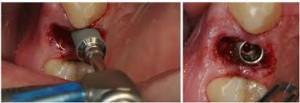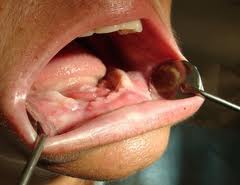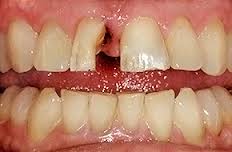Implant placement after tooth extraction

As a result of tooth loss, the jawbone ceases to fulfill the functional load, which leads to its atrophy.
A decrease in bone volume can significantly limit future implantation.
Therefore, to maintain the efficiency of the dentition, it is important to timely restore lost teeth.
The faster implants are installed after tooth extraction, the more likely they are to prevent bone atrophy.
Implantation methods after tooth extraction
Modern implantology offers several approaches to tooth extraction and subsequent implant implantation:
- Classical dental implantation provides for a waiting period of up to two months after tooth extraction with subsequent implantation. During this time, atrophic changes in the bone tissue of the jaw occur.
- Immediate implantation is a method in which a tooth is removed and an implant is inserted in one visit to a doctor.
The advantage of this method is the ability to prevent bone loss, maintains an aesthetic contour of the gums and significantly saves time.
In some cases, a temporary dental crown is immediately installed on the implanted implant, which allows the patient to leave the dentist’s office with full teeth.
This approach to implantation takes place in the absence of contraindications to implantation and the presence of a qualified specialist.
Contraindications
I can be both absolute and relative. In the presence of absolute contraindications to the operation, its implementation becomes impossible.
These contraindications include:

- Loosening the bone.
- Bone atrophy.
- Reduced immunity.
- Diseases of the endocrine system, diabetes mellitus.
- Periodontal disease.
- The presence of a wide hole in the extracted tooth, if it is impossible to tightly install the implant.
- Inflammation of the jaw bone, the presence of cysts, granulomas.
- The presence of cancer.
- Inflammatory processes of the oral cavity.
- Diseases of the psyche.
- The presence of allergies to pain medications.
- AIDS. Venereal diseases.
- Tuberculosis and its complications.
- Diseases of the blood and blood-forming organs.
- Connective tissue diseases.
- Increased tonus of chewing muscles.
Relative contraindications to the installation of implants after tooth extraction, in contrast to absolute ones, are easily eliminated.
These include:

- Carious rotten teeth.
- Poor hygiene care for the oral cavity.
- Drug addiction, addiction to smoking, alcoholism.
- Deep bite.
- State of pregnancy.
- Periodontitis, stomatitis, gingivitis.
- Inflammatory diseases of the joints.
There are general contraindications to tooth implantation after removal:
- Chronic somatic diseases in the acute stage.
- The use of drugs that affect blood coagulation, antidepressants, etc.
- A state of prolonged stress.
- The exhaustion of the body.
The following factors can interfere with simultaneous implantation:
- the presence of an inflammatory process in the oral cavity;
- inflammatory process around the removed tooth;
- the presence of fistulas;
- periodontal disease;
- lack of bone tissue and loosening of its structure.
In the presence of this pathology, the operation can be postponed for the duration of the treatment and bone growth.
Indications
Immediate implantation is possible only at the age of a patient older than 18 years, because at this point bone growth ends.

- The presence of a tooth injury.
- Fracture of the tooth root.
- Destruction of the crown and partial destruction of the tooth root as a result of chronic periodontitis.
- Lack of results treatment of chronic periodontitis.
- Periodontitis.
- Indications for tooth extraction for prosthetics.
Method Criteria
Tooth implant after removalcarried out only in cases where there are no contraindications and there is a sufficient amount of bone tissue.
The final choice of implantation technique is carried out by the doctor, after a thorough examination of the patient, evaluating all the pros and cons of this technology.
If there are contraindications for the operation, implantation is carried out three to six months after the healing of the hole and the formation of bone tissue.
Today, as several years ago, dentists rarely use this method.
Immediate implantation of an implant in a fresh hole of a extracted tooth carries certain risks:
- When a tooth is removed, bone damage often occurs.
- During implantation, the risk of complications increases.
- Inability to create an implant adequate to the shape of the tooth that has been removed. There may be problems with engraftment due to the loose fit of the implant to the bone surface.
Conditions
The following conditions are required for tooth extraction and implant placement:
- The presence of healthy teeth next to the implant to prevent loosening.
- Corresponding to the size of the jawbone and implantable implant.
- Good bone quality.
- Satisfactory general condition of the body.
- Adequate bone density.
- Availability of stabilization of the structure at the time of its installation.
- A sufficient number of healthy teeth.
- The absence of risk factors affecting the outcome of the operation.
Video: “How to save a smile? Dental Implantation
Requirements
If you follow the requirements for implantation after tooth extraction, you can avoid complications of implantation.
Requirements for the installation of implants:
- The presence of good quality bone tissue.
- The possibility of surgery with implants having a length of 13 to 16 mm.
- A sufficient amount of gum tissue.
- The presence of teeth near the implant that are able to take on the main load during implant engraftment.
Questions and answers
- Question: What to do if it is necessary to remove a tooth?
Answer: If there is no acute process, then it is better to try to immediately restore the tooth using implantation.
- Question: Why is it better to immediately implant the implant and not wait when the hole overgrows?
Answer: After tooth extraction, bone tissue atrophy occurs after some time. The bone becomes thinner and lower than that of natural teeth. The implant can be installed only after preliminary bone tissue extension.
- Question: Which is better - implantation or bridge prosthetics?
Answer: The installation of a bridge structure requires the preparation of supporting teeth. For implantation, this is not necessary.The advantage of implantation is that the artificial crown on the implant looks more natural than on the bridge.
- Question: How long does the implant engraftment last?
Answer: Osteointegration occurs within 4 to 6 months. During this time, a temporary crown is used, which after engraftment is replaced by a permanent structure.